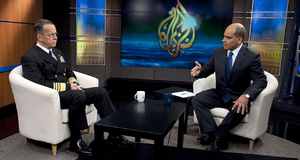As a satirical news program, The Daily Show has critiqued the various news networks for their shortcomings. Stewart, as an individual media critic, has also been highly critical of particular shows and networks. Stewart typically criticizes media and journalistic programs for either not living up to their networks’ claim or not fulfilling their roles in an effective and responsible manner. Straying from comedy, he has taken on CNN’s Crossfire, CNBC and Jim Cramer, Fox News and Bill O’Reilly, and other media figures. The first two will be the focus of this section.
From 1982 to 2005, CNN’s debate program Crossfire traditionally featured political commentators from the left and from the right, where each side would discuss its opinion on the topic at hand. Hosts have included Pat Buchanan, Robert Novak, Paul Begala, James Carville, and Tucker Carlson. In 2004, Stewart was invited on Crossfire with the network expecting him to promote his new book, but instead he ended up expressing virtually unheard of criticism about the show itself to hosts Begala and Carlson.
Crossfire: Jon Stewart Interview
Two main themes emerge from this interview. First, Stewart claims that the show and hosts are “hurting America” by not fulfilling their responsibility. Stewart affirms, “[the people] need your help… right now you are helping the politicians and the corporations… you’re partisan… hacks.” He additionally argues that the hosts are “doing theater, when [they] should be doing debate.” On that same note, although Begala asserts that Crossfire is a debate show, Stewart counters, contending that while the show may intend to be a debate show, it comes across more as basic partisan reactions that oversimplify the arguments. Moreover, Stewart expresses a strong desire for a substantive debate show, but, according to Stewart, Crossfire does not make the cut.
The second theme is Stewart’s assertion that it is ridiculous for a news program or serious talk show to compare itself and its standards to The Daily Show. Carlson repeatedly attempts to criticize Stewart’s recent interview with Democratic presidential nominee, Senator John Kerry, only to be challenged by Stewart: “If you want to compare your show to a comedy show you are more than welcome to.” Many critics of Stewart and The Daily Show try to turn around Stewart’s attacks to target the comedy program instead. However, Stewart argues that The Daily Show never claims to be an actual debate show, news program, or tough interview program, and, thus, cannot be held to the same level of scrutiny as a show on CNN, MSNBC, or Fox. Stewart further adds, “you have a responsibility to the public discourse and you fail miserably,” driving home the fact that Crossfire does not accomplish its stated goal of being an informative debate show.
Based on the initial questions that Carlson was able to ask Stewart, it seemed likely that the interview was going to be focused around the 2004 presidential elections. Stewart, however, acts as what Mirjam Gollmitzer would call an adversarial guest. In her paper "Towards a Media Incidents Theory: How "Adversarial Guests" Ruin Programs and Liberate the Audience," Gollmitzer argues that by shifting the discussion away from “the political deficiencies of Democrats and Republicans,” Stewart was able to “[turn] to issues directly [relating] to the media itself – to the particular channel, [program], or host.” Stewart, from the outset, came onto the program determined to rebuke Crossfire, always attempting to make his way back to his initial claims, despite Begala’s and Carlson’s persistent efforts to move away from the strong condemnation of the program. By vying for control and often interrupting the hosts, Stewart altered the attitude and direction of the program enough so that he could frame the discussion around the subject of his choice, which in this case was his belief that Crossfire was “hurting America.”
Regardless of whether or not Begala and Carlson agreed with Stewart, or whether one has seen much of Crossfire to determine if Stewart’s argument is sound, what is significant is that Crossfire was cancelled two months after Stewart’s appearance. Ross Douthat, of The New York Times, summarizes the network’s decision:
“As it turned out, CNN was paying attention… [T]he network’s president, Jon Klein, cited Stewart’s tirade as a tipping point. “I agree wholeheartedly with Jon Stewart’s overall premise,” Klein said. Henceforward, he announced, CNN would move away from “head-butting debate shows.” Let Fox and MSNBC have their “live guests” and “spirited debate.” CNN was going to report, not editorialize.”
Stewart’s live remarks on Crossfire brought significant negative attention to the show, enough that the president of the network felt comfortable using Stewart’s appearance as one of the reasons the show was discontinued. Nancy Snow, of The Huffington Post, believes that “it was Stewart's appearance on CNN's Crossfire... that cemented his reputation as the only honest broker about what was happening to the real news.” Snow also compliments Stewart in stating that “[he] said what so many Americans were thinking but were in no position to say… It took America's most prominent shtick journalist to tell pseudo journalists to stop using false advertising labels about what it is they were doing.” And the “false advertising” is essential to Stewart. This criticism was recognized earlier in the paper with Fox News’ “Fair and Balanced” slogan and again here with Crossfire being considered a true debate show.
Beyond Stewart’s claims, though, is a larger point. Stewart is trying to hold the show accountable to the public. He specifically mentions that Carlson and Begala, and others like them, fit right into the “strategies” of the politicians and corporations. Although he has been critiquing the news networks on The Daily Show for some time, his direct live criticism of Crossfire on Crossfire strengthened his reputation as a media critic. His criticism even contributed to the cancellation of the program itself. Furthermore, Gollmitzer describes what might be the most valuable aspect of Stewart’s appearance:
“When suddenly being exposed to the messiness of an unarranged reality, without a clear-cut media-made frame for interpretation, the audiences of those media incidents felt the need to comment, debate and argue with others. Thereby, these audiences engaged in a broad public discourse about politically important issues such as the… quality of political talk shows. While doing that, they experienced themselves as an interpretive community – an experience that has become rare in the age of individualized media consumption.”
By calling out and mocking the poor quality of discourse on Crossfire, Stewart not only affected the very existence of the program, but he also stimulated public discussion about the media’s role in the democratic process.Continued on Next Page »
1.) Baym, Geoffrey. “The Daily Show: Discursive Integration and the Reinvention of Political Journalism.” Political Communication. 2005. 22: 3, 259-276.
Brewer, Paul R. and Emily Marquardt. “Mock News and Democracy: Analyzing The Daily Show.” Atlantic Journal of Communication. Lawrence Erlbaum Associates, Inc. 2007. 15:4, 249-267.
4.) “Remembering Anna.” The Daily Show with Jon Stewart. Comedy Central. February 12, 2007. Web. October 26, 2010. <http://www.thedailyshow.com/watch/mon-february-12-2007/remembering-anna>.
5.) “Shut Up Mark Sanford.” The Daily Show with Jon Stewart. Comedy Central. July 12, 2009. Web. October 26, 2010. <http://www.thedailyshow.com/watch/thu-july-2-2009/shut-up--mark-sanford>.
6.) “The Wedding of the Century of the Millennium.” The Daily Show with Jon Stewart. Comedy Central. August 2, 2010. Web. October 26, 2010. <http://www.thedailyshow.com/watch/mon-august-2-2010/wedding-of-the-decade-of-the-century-of-the-millennium >.
“Headlines Duke Lacrosse Rape Allegations.” The Daily Show with Jon Stewart. Comedy Central. April 18, 2006. Web. October 26, 2010. <http://www.thedailyshow.com/watch/tue-april-18-2006/headlines---duke-lacrosse-rape-allegations>.
9.) “Headlines Duke Lacrosse Rape Allegations.” The Daily Show with Jon Stewart. Comedy Central. April 18, 2006. Web. October 26, 2010. <http://www.thedailyshow.com/watch/tue-april-18-2006/headlines---duke-lacrosse-rape-allegations>.
10.) “Journalism, Satire or Just Laughs? ‘The Daily Show with Jon Stewart,’ Examined.” Pew Research Center’s Project for Excellence in Journalism. N.p., May 8, 2008. Web. October 26, 2010. <http://www.journalism.org/node/10953>.
11.) Who the f@#k is that guy? – Political Experts.” The Daily Show with Jon Stewart. Comedy Central. October 22, 2008. Web. October 28, 2010. <http://www.thedailyshow.com/watch/wed-october-22-2008/who-the-f--k-is-that-guy----political-experts>.
13.) “Hi Tech News Coverage.” The Daily Show with Jon Stewart. Comedy Central. January 9, 2008. Web. October 28, 2010. <http://www.thedailyshow.com/watch/wed-january-9-2008/hi-tech-news-coverage>.
14.) “Speech Therapy.” The Daily Show with Jon Stewart. Comedy Central. January 28, 2010. Web. November 4, 2010. <http://www.thedailyshow.com/watch/thu-january-28-2010/speech-therapy---post-racial>.
15.) “CNN Leaves It There.” The Daily Show with Jon Stewart. Comedy Central. October 12, 2009. Web. November 1, 2010. <http://www.thedailyshow.com/watch/mon-october-12-2009/cnn-leaves-it-there>.
17.) “CNN Leaves It There.” The Daily Show with Jon Stewart. Comedy Central. October 12, 2009. Web. November 1, 2010. <http://www.thedailyshow.com/watch/mon-october-12-2009/cnn-leaves-it-there>.
18.) “MSNBC Left Behind.” The Daily Show with Jon Stewart. Comedy Central. October 11, 2010. Web. November 3, 2010. <http://www.thedailyshow.com/watch/mon-october-11-2010/msnbc-left-behind>.
19.) “Keith Olbermann’s Name Calling.” The Daily Show with Jon Stewart. Comedy Central. January 21, 2010. Web. November 4, 2010. <http://www.thedailyshow.com/watch/thu-january-21-2010/special-comment---keith-olbermann-s-name-calling>.
20.) “Speech Therapy.” The Daily Show with Jon Stewart. Comedy Central. January 28, 2010. Web. November 4, 2010. <http://www.thedailyshow.com/watch/thu-january-28-2010/speech-therapy---post-racial>.
21.) “Fox News.Com.” Fox News Network, LLC. November 4, 2010. 2010. <http://www.foxnews.com/>.
22.) “For Fox Sake.” The Daily Show with Jon Stewart. Comedy Central. October 29, 2009. Web. November 4, 2010. <http://www.thedailyshow.com/watch/thu-october-29-2009/for-fox-sake->.
24.) “Anchor Management.” The Daily Show with Jon Stewart. Comedy Central. March 3, 2010. Web. November 4, 2010. <http://www.thedailyshow.com/watch/wed-march-3-2010/anchor-management>.
“Gretchen Carlson Dumbs Down.” The Daily Show with Jon Stewart. Comedy Central. December 8, 2009. Web. November 6, 2010. <http://www.thedailyshow.com/watch/tue-december-8-2009/gretchen-carlson-dumbs-down>.
“Sean Hannity Uses Glenn Beck’s Protest Footage.” The Daily Show with Jon Stewart. Comedy Central. November 10, 2009. Web. November 6, 2010. <http://www.thedailyshow.com/watch/tue-november-10-2009/sean-hannity-uses-glenn-beck-s-protest-footage>.
33.) “Sean Hannity Apologizes to Jon.” The Daily Show with Jon Stewart. Comedy Central. November 12, 2009. Web. July 16, 2011. <http://www.thedailyshow.com/watch/thu-november-12-2009/sean-hannity-apologizes-to-jon>.
34.) “Are You Ready For Some Midterms? – MSNBC’s Political Narrative.” The Daily Show with Jon Stewart. Comedy Central. September 9, 2010. Web. November 6, 2010. <http://www.thedailyshow.com/watch/thu-september-9-2010/are-you-ready-for-some-midterms----msnbc-s-political-narrative>.
35.) “Kurtz criticizes Hannity's "careful editing" of Obama speech: "Isn't that kind of editing, what's the word, deceptive?" Media Matters For America. September 12, 2010. Web. November 6, 2010. >.
36.) “Bernie Goldberg Fires Back.” The Daily Show with Jon Stewart. Comedy Central. April 20, 2010. Web. November 6, 2010. <http://www.thedailyshow.com/watch/tue-april-20-2010/bernie-goldberg-fires-back>.
37.) “Top TV Feuds: Jon Stewart vs. Crossfire.” TIME. Time.com. 2010. <http://www.time.com/time/specials/packages/article/0,28804,1884499_1884515_1884462,00.html>.
Gollmitzer, Mirjam. "Towards a Media Incidents Theory: How "Adversarial Guests" Ruin Programs and Liberate the Audience."Conference Papers -- International Communication Association(2009): 1-20. Communication & Mass Media Complete. EBSCO. Web. 20 Nov. 2010.
44.) Douthat, Ross. “Can CNN Be Saved?” The New York Times. April 4, 2010. <http://www.nytimes.com/2010/04/05/opinion/05douthat.html>.
Snow, Nancy. “Jon Stewart: Still the Most Trusted Newscaster in America.” The Huffington Post. July 23, 2009. <http://www.huffingtonpost.com/nancy-snow/jon-stewart-still-the-mos_b_243646.html>.
47.) Gollmitzer, Mirjam. "Towards a Media Incidents Theory: How "Adversarial Guests" Ruin Programs and Liberate the Audience."Conference Papers -- International Communication Association(2009): 1-20.Communication & Mass Media Complete. EBSCO. Web. 20 Nov. 2010.
“CNBC Financial Advice.” The Daily Show with Jon Stewart. Comedy Central. March 4, 2009. Web. November 20, 2010. <http://www.thedailyshow.com/watch/wed-march-4-2009/cnbc-financial-advice>.
52.) Cramer, Jim. “Cramer Takes on White House, Frank Rich, and Jon Stewart.” The Street. MainStreet.com. March 10, 2009. <http://www.mainstreet.com/article/moneyinvesting/news/cramer-takes-white-house-frank-rich-and-jon-stewart?page=4>.
“In Cramer We Trust.” The Daily Show with Jon Stewart. Comedy Central. March 9, 2009. Web. November 20, 2010. <http://www.thedailyshow.com/watch/mon-march-9-2009/in-cramer-we-trust>.
“Basic Cable Personality Clash Skirmish.” The Daily Show with Jon Stewart. Comedy Central. March 10, 2009. Web. November 20, 2010. <http://www.thedailyshow.com/watch/tue-march-10-2009/basic-cable-personality-clash-skirmish--09>.
“Jim Cramer Extended Interview Pt. 1.” The Daily Show with Jon Stewart. Comedy Central. March 12, 2009. Web. November 21, 2010. <http://www.thedailyshow.com/watch/thu-march-12-2009/jim-cramer-extended-interview-pt--1>.
“Jim Cramer Extended Interview Pt. 2.” The Daily Show with Jon Stewart. Comedy Central. March 12, 2009. Web. November 21, 2010. <http://www.thedailyshow.com/watch/thu-march-12-2009/jim-cramer-extended-interview-pt--2>.
“Jim Cramer Extended Interview Pt. 3.” The Daily Show with Jon Stewart. Comedy Central. March 12, 2009. Web. November 21, 2010. <http://www.thedailyshow.com/watch/thu-march-12-2009/jim-cramer-extended-interview-pt--3>.
64.) Snow, Nancy. “Jon Stewart: Still the Most Trusted Newscaster in America.” The Huffington Post. July 23, 2009. <http://www.huffingtonpost.com/nancy-snow/jon-stewart-still-the-mos_b_243646.html>.
65.) France, Lisa Respers. “Stewart seen as winner in Showdown with Cramer.” March 19, 2009. CNN.com. 2009. <http://www.cnn.com/2009/SHOWBIZ/TV/03/13/cramer.stewart.reaction/index.html?iref=allsearch>.
66.) Carlson, Tucker. “How Jon Stewart Went Bad.” The Daily Beast: Blogs & Stories. March 18, 2009. RTST, Inc. 2010. <http://www.thedailybeast.com/blogs-and-stories/2009-03-18/how-jon-stewart-went-bad/>.
67.) Fisher, Luchina. “Jon Stewart Wins Cramer Showdown.” March 13, 2009. ABC News Internet Ventures. 2010. <http://abcnews.go.com/Entertainment/Television/story?id=7075368&page=1>.
68.) Cohen, Richard. “Don’t Blame Jim Cramer.” The Washington Post. March 17, 2009. <http://www.washingtonpost.com/wpdyn/content/article/2009/03/16/AR2009031602319.html>.
France, Lisa Respers. “Stewart seen as winner in Showdown with Cramer.” March 19, 2009. CNN.com. <http://www.cnn.com/2009/SHOWBIZ/TV/03/13/cramer.stewart.reaction/index.html?iref=allsearch>.
“Journalism, Satire or Just Laughs? ‘The Daily Show with Jon Stewart,’ Examined.” Pew Research Center’s Project for Excellence in Journalism. N.p., May 8, 2008. Web. October 26, 2010. <http://www.journalism.org/node/10953>.
72.) “Mike Huckabee Pt.2.” The Daily Show with Jon Stewart. Comedy Central. December 9, 2008. Web. April 21, 2011. <http://www.thedailyshow.com/watch/tue-december-9-2008/mike-huckabee-pt--2>.
“Newt Gingrich.” The Daily Show with Jon Stewart. Comedy Central. February 9, 2010. Web. April 21, 2011. <http://www.thedailyshow.com/watch/tue-february-9-2010/newt-gingrich>.
“Exclusive John Yoo Extended Interview Pt.1.” The Daily Show with Jon Stewart. Comedy Central. January 11, 2010. Web. April 21, 2011. <http://www.thedailyshow.com/watch/mon-january-11-2010/exclusive---john-yoo-extended-interview-pt--1>.
77.) “Exclusive Marc Thiessen Extended Interview Pt.1.” The Daily Show with Jon Stewart. Comedy Central. March 9, 2010. Web. April 21, 2011. <http://www.thedailyshow.com/watch/tue-march-9-2010/exclusive---marc-thiessen-extended-interview-pt--1>.
78.) Douthat, Ross. “Can CNN Be Saved?” The New York Times. April 4, 2010. <http://www.nytimes.com/2010/04/05/opinion/05douthat.html>.
79.) “Exclusive John Yoo Extended Interview Pt.3.” The Daily Show with Jon Stewart. Comedy Central. January 11, 2010. Web. April 21, 2011. <http://www.thedailyshow.com/watch/mon-january-11-2010/exclusive---john-yoo-extended-interview-pt--3>.
80.) “Barack Obama Pt.1.” The Daily Show with Jon Stewart. Comedy Central. October 27, 2010. Web. April 30, 2011. <http://www.thedailyshow.com/watch/wed-october-27-2010/barack-obama-pt--1>.
81.) “Eye to Eye: Obama on Stewart (CBS News).” CBS News. YouTube. August 23, 2007. <http://www.youtube.com/watch?v=6f3nQPJfgPo&feature=fvw>.
“Journalism, Satire or Just Laughs? ‘The Daily Show with Jon Stewart,’ Examined.” Pew Research Center’s Project for Excellence in Journalism. N.p., May 8, 2008. Web. October 26, 2010. <http://www.journalism.org/node/10953>.
84.) Douthat, Ross. “Can CNN Be Saved?” The New York Times. April 4, 2010. <http://www.nytimes.com/2010/04/05/opinion/05douthat.html>.
85.) Baym, Geoffrey. “The Daily Show: Discursive Integration and the Reinvention of Political Journalism.” Political Communication. 2005. 22: 3, 259-276.
86.) “So You Think You Can Douche.” The Daily Show with Jon Stewart. Comedy Central. July 29, 2009. Web. April 30, 2011. <http://www.thedailyshow.com/watch/wed-july-29-2009/so-you-think-you-can-douche>.
87.) “Sarah Palin Gender Card.” The Daily Show with Jon Stewart. Comedy Central. September 3, 2008. Web. April 30, 2011. <http://www.thedailyshow.com/watch/wed-september-3-2008/sarah-palin-gender-card>.
88.) “Sarah Palin Gender Card.” The Daily Show with Jon Stewart. Comedy Central. September 3, 2008. Web. April 30, 2011. <http://www.thedailyshow.com/watch/wed-september-3-2008/sarah-palin-gender-card>.
89.) “Postcards From the Pledge.” The Daily Show with Jon Stewart. Comedy Central. September 23, 2010. Web. April 30, 2011. <http://www.thedailyshow.com/watch/thu-september-23-2010/postcards-from-the-pledge>.
90.) “Postcards From the Pledge.” The Daily Show with Jon Stewart. Comedy Central. September 23, 2010. Web. April 30, 2011. <http://www.thedailyshow.com/watch/thu-september-23-2010/postcards-from-the-pledge>.
“Moral Kombat.” The Daily Show with Jon Stewart. Comedy Central. May 14, 2009. Web. April 30, 2011. <http://www.thedailyshow.com/watch/thu-may-14-2009/moral-kombat>.
93.) Shear, Michael. “From Jon Stewart, Echoes of G.O.P. Past.” The New York Times. September 24, 2010. <http://thecaucus.blogs.nytimes.com/2010/09/24/from-jon-stewart-echoes-of-g-o-p-past/?scp=1&sq=jon%20stewart%20postcards%20from%20the%20pledge&st=cse>.
94.) Gore, Al. The Assault on Reason. Penguin Books. New York, NY. 2007. 111.
95.) “I Give Up – 9/11 Responders.” The Daily Show with Jon Stewart. Comedy Central. August 4, 2010. Web. April 30, 2011. <http://www.thedailyshow.com/watch/wed-august-4-2010/i-give-up---9-11-responders-bill>.
96.) “Republicans Block 9/11 Health Care Bill.” The Daily Show with Jon Stewart. Comedy Central. December 9, 2010. Web. April 30, 2011. <http://www.thedailyshow.com/watch/thu-december-9-2010/republicans-block-9-11-health-care-bill>.
97.) “Worst Responders.” The Daily Show with Jon Stewart. Comedy Central. December 16, 2010. Web. April 30, 2011. <http://www.thedailyshow.com/watch/thu-december-16-2010/worst-responders>.
98.) “9/11 First Responders React to the Senate Filibuster.” The Daily Show with Jon Stewart. Comedy Central. December 16, 2010. Web. April 30, 2011. <http://www.thedailyshow.com/watch/thu-december-16-2010/9-11-first-responders-react-to-the-senate-filibuster>.
99.) “Exclusive – Mike Huckabee Extended Interview.” The Daily Show with Jon Stewart. Comedy Central. December 16, 2010. Web. April 30, 2011. <http://www.thedailyshow.com/watch/thu-december-16-2010/exclusive---mike-huckabee-extended-interview>.
100.) Newton-Small, Jay. “Did Jon Stewart Turn the Tide on the 911 First Responders Bill?” TIME: Swampland. December 20, 2010. Time, Inc. 2011. <http://swampland.blogs.time.com/2010/12/20/did-jon-stewart-turn-the-tide-on-the-911-first-responders-bill/>.
101.) “New Hope for 9/11 Heroes.” FOX NEWS. Fox News Network, LLC. December 20, 2010. <http://video.foxnews.com/v/4469087/new-hope-for-911-heroes>.
102.) Hernandez, Raymond. “Senate Passes 9/11 Health Bill as Republicans Back Down.” The New York Times. December 22, 2010. <http://www.nytimes.com/2010/12/23/nyregion/23health.html?_r=1>.
103.) Madison, Lucy. “White House Lauds Jon Stewart for Pushing Passage of 9/11 Health Bill.” CBS News.com. Political Hotsheet. December 21, 2010. <http://www.cbsnews.com/8301-503544_162-20026333-503544.html>.
Carter, Bill and Brian Stelter. “In ‘Daily Show’ Role on 9/11 Bill, Echoes of Murrow.” The New York Times. December 26, 2010. <http://www.nytimes.com/2010/12/27/business/media/27stewart.html?pagewanted=1&_r=1>.
“Kirsten Gillibrand.” The Daily Show with Jon Stewart. Comedy Central. January 4, 2011. Web. April 30, 2011. <http://www.thedailyshow.com/watch/tue-january-4-2011/kirsten-gillibrand>.
Baym, Geoffrey. “The Daily Show: Discursive Integration and the Reinvention of Political Journalism.” Political Communication. 2005. 22: 3, 259-276.
110.) Stelter, Brian. “In Visit to Fox News, Jon Stewart Faults Fox News.” The New York Times. February 5, 2010. <http://www.nytimes.com/2010/02/06/arts/television/06fox.html?scp=2&sq=jon%20stewart&st=cse>.
111.) “Entire Jon Stewart Interview.” FOX NEWS. Fox News Network, LLC. February 4, 2010. <http://video.foxnews.com/v/4003531/entire-jon-stewart-interview/>.

















